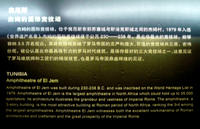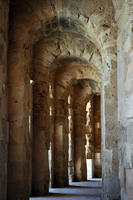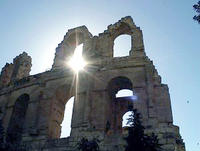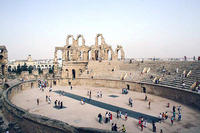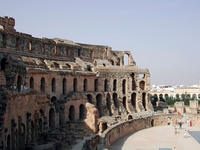You are in: Africa -> Tunisia -> Amphitheatre of El Jem, and traditional search or Image Gallery will yield results of this site only
Amphitheatre of El Jem
| Site number: | 38 |
|
| Type of site: | Cultural | |
| Date: | 3rd-century | |
| Date of Inscription: | 1979 | |
| Location: | Africa, Tunisia, El-Mahdia | |
Up to 75 images are shown here. Click on each for more details or on Image Gallery for more images.
| Description: | The tiny village of El Jem possesses the striking ruins of North Africa’s largest colosseum, a massive amphitheatre which could accommodate up to 35,000 audience members. This 3rd-century monument demonstrates the splendor as well as the scope of Imperial Rome. --WHMNet paraphrase from the description at WHC Site, where additional information is available. | |
| El Djem (Latin Thysdrus) is a town in Mahdia Governorate, Tunisia, population 18,302 (2004 census). It is home to some of the most impressive Roman remains in Africa. The city was built, like almost all Roman settlements in Tunisia, on former Punic settlements. In a less arid climate than today's, Roman Thysdrus prospered especially in the 2nd century, when it became an important centre of olive oil manufacturing for export. It was the seat of a Christian bishop - which is still occupied by a titular Roman Catholic bishop today. By the early 3rd Century AD, when the amphitheatre was built, Thysdrus rivalled Hadrumetum (modern Sousse) as the second city of Roman North Africa, after Carthage. However, following the abortive revolt that began there in 238 AD, and Gordian I's suicide in his villa near Carthage, Roman troops loyal to the Emperor Maximinus Thrax destroyed the city. It never really recovered. How thorough the destruction was in the 3rd century is not known. Perhaps there was a garbage dump at Thysdrus like the one at Oxyrhyncus. --Wikipedia. Text is available under the Creative Commons Attribution-ShareAlike License. | ||
| Source: | http://whc.unesco.org/en/list/38 | |
| Reference: | 1. UNESCO World Heritage Center, Site Page. | |



